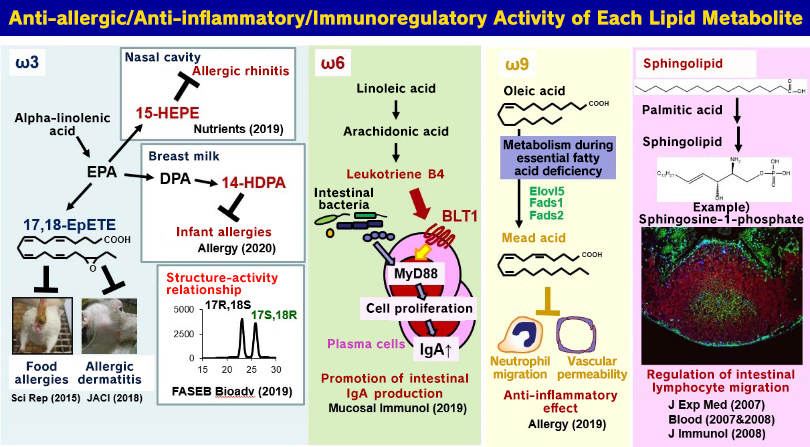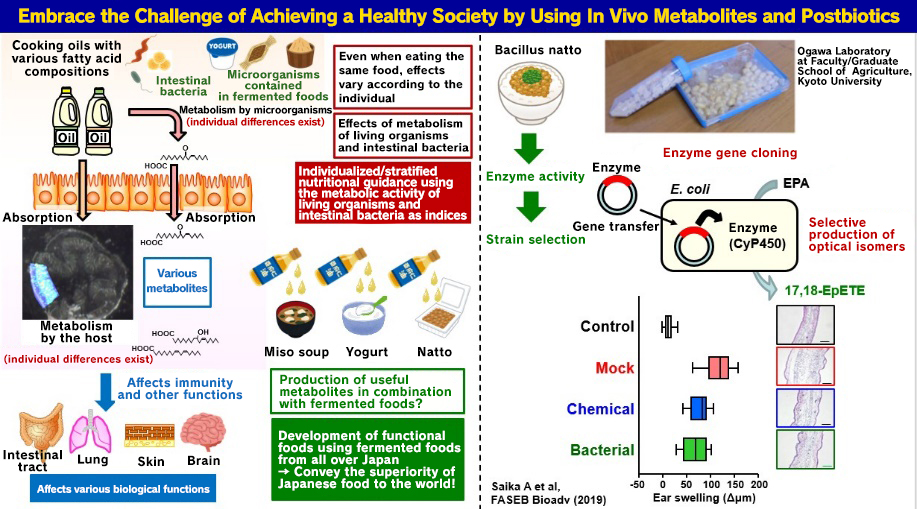

Currently, the workings of immunity are once again attracting attention, partly due to the COVID-19 pandemic. It is said that more than half of the body’s immune cells are concentrated in the intestinal tract. These cells affect the immune function of the entire body, not just the intestinal tract, and are involved in biological defense against pathogens and the development of immune diseases. Furthermore, although lifestyle-related diseases such as diabetes were previously thought to be unrelated to immunity, it is becoming clear that immunity is also involved in these diseases. For these reasons, attention is currently being placed on the relationship among health, illness, and the intestinal tract, including individual differences in immune function. In particular, research is being conducted with a focus on dietary components and intestinal bacteria as factors that control immunity.
Among these dietary components, our research group has obtained the following findings from research focusing on oil.

- 1. Sphingosine-1-phosphate, which is a lipid metabolite metabolized and produced from substances such as sphingomyelin, affects vaccine efficacy by controlling the pharmacokinetics of cells that produce IgA antibodies.
- 2. Sphingosine-1-phosphate also plays an important role in the barrier function at the outermost surface of the intestinal tract. Specifically, it is involved in the migration of interepithelial T lymphocytes existing in the intestinal epithelial cell layer.
- 3. Palmitic acid, an abundant substance in palm oil, is converted into sphingolipids in the body. These sphingolipids enhance the production of intestinal IgA antibodies.
- 4. The growth of cells that produce IgA antibodies through a process dependent on intestinal bacteria is regulated by leukotriene B4 derived from arachidonic acid, which is one of the omega-6 fatty acids, and by the associated receptor BLT1.
- 5. Ingestion of linseed oil, which is rich in the omega-3 fatty acid alpha-linolenic acid, produces different lipid metabolites in various parts of the body. It also suppresses allergic and inflammatory reactions via different pathways.
- 6. Mead acid, which is produced in the body by ingesting coconut oil, suppresses allergic dermatitis.
Moreover, recent research has shown that immunomodulatory lipid metabolites are produced not only by our bodies, but also by intestinal bacteria and the microorganisms found in fermented foods. Useful metabolites produced by these intestinal bacteria and other microorganisms are attracting attention under a new concept known as “postbiotics.” Through our recent research, our group discovered that antiallergic lipids can be produced by adding omega-3 fatty acids to certain types of bacillus subtilis, including bacillus natto.
When considering these discoveries, it can be hypothesized that one of the reasons why eating the same foods has varying effects on different people is the difference in the metabolism of individuals and intestinal bacteria. Focusing on this idea, our group is conducting research aimed at formulating nutritional guidance systems for individualization or stratification. We use the metabolic activity of living organisms and intestinal bacteria as indices when creating these systems. In addition to basic research using animal models, our research also includes analysis using information and samples collected from cohorts that we independently established in various regions of Japan. As of the current point in time, we have collected data on nearly 4,000 people.

Our group will engage in reverse translational research, which consists of using bioinformatics technology to analyze the collected data and then using techniques such as animal models to verify the estimated pathways. We expect that this research will clarify new functions of the intestinal environment.
|